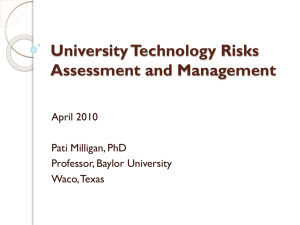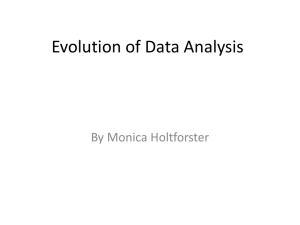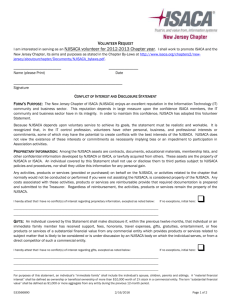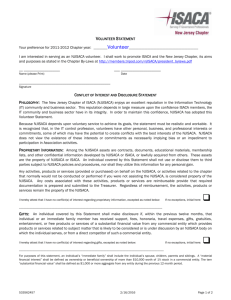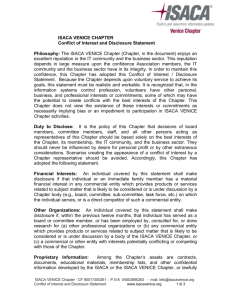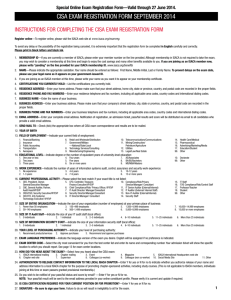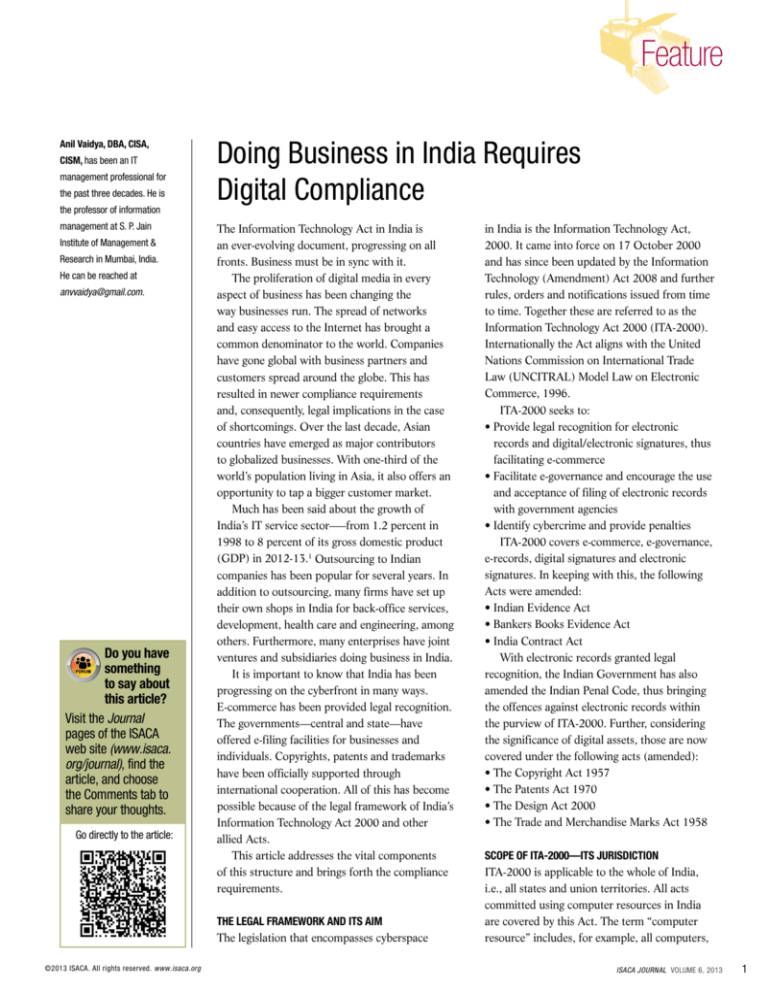
Feature
Anil Vaidya, DBA, CISA,
CISM, has been an IT
management professional for
the past three decades. He is
the professor of information
management at S. P. Jain
Institute of Management &
Research in Mumbai, India.
He can be reached at
anvvaidya@gmail.com.
Do you have
something
to say about
this article?
Visit the Journal
pages of the ISACA
web site (www.isaca.
org/journal), find the
article, and choose
the Comments tab to
share your thoughts.
Go directly to the article:
Doing Business in India Requires
Digital Compliance
The Information Technology Act in India is
an ever-evolving document, progressing on all
fronts. Business must be in sync with it.
The proliferation of digital media in every
aspect of business has been changing the
way businesses run. The spread of networks
and easy access to the Internet has brought a
common denominator to the world. Companies
have gone global with business partners and
customers spread around the globe. This has
resulted in newer compliance requirements
and, consequently, legal implications in the case
of shortcomings. Over the last decade, Asian
countries have emerged as major contributors
to globalized businesses. With one-third of the
world’s population living in Asia, it also offers an
opportunity to tap a bigger customer market.
Much has been said about the growth of
India’s IT service sector—–from 1.2 percent in
1998 to 8 percent of its gross domestic product
(GDP) in 2012-13.1 Outsourcing to Indian
companies has been popular for several years. In
addition to outsourcing, many firms have set up
their own shops in India for back-office services,
development, health care and engineering, among
others. Furthermore, many enterprises have joint
ventures and subsidiaries doing business in India.
It is important to know that India has been
progressing on the cyberfront in many ways.
E-commerce has been provided legal recognition.
The governments—central and state—have
offered e-filing facilities for businesses and
individuals. Copyrights, patents and trademarks
have been officially supported through
international cooperation. All of this has become
possible because of the legal framework of India’s
Information Technology Act 2000 and other
allied Acts.
This article addresses the vital components
of this structure and brings forth the compliance
requirements.
The Legal Framework and Its Aim
The legislation that encompasses cyberspace
©2013 ISACA. All rights reserved. www.isaca.org
in India is the Information Technology Act,
2000. It came into force on 17 October 2000
and has since been updated by the Information
Technology (Amendment) Act 2008 and further
rules, orders and notifications issued from time
to time. Together these are referred to as the
Information Technology Act 2000 (ITA-2000).
Internationally the Act aligns with the United
Nations Commission on International Trade
Law (UNCITRAL) Model Law on Electronic
Commerce, 1996.
ITA-2000 seeks to:
• Provide legal recognition for electronic
records and digital/electronic signatures, thus
facilitating e-commerce
• Facilitate e-governance and encourage the use
and acceptance of filing of electronic records
with government agencies
• Identify cybercrime and provide penalties
ITA-2000 covers e-commerce, e-governance,
e-records, digital signatures and electronic
signatures. In keeping with this, the following
Acts were amended:
• Indian Evidence Act
• Bankers Books Evidence Act
• India Contract Act
With electronic records granted legal
recognition, the Indian Government has also
amended the Indian Penal Code, thus bringing
the offences against electronic records within
the purview of ITA-2000. Further, considering
the significance of digital assets, those are now
covered under the following acts (amended):
• The Copyright Act 1957
• The Patents Act 1970
• The Design Act 2000
• The Trade and Merchandise Marks Act 1958
Scope of ITA-2000—Its Jurisdiction
ITA-2000 is applicable to the whole of India,
i.e., all states and union territories. All acts
committed using computer resources in India
are covered by this Act. The term “computer
resource” includes, for example, all computers,
ISACA JOURNAL VOLUME 6, 2013
1
cell phones, mobile devices, databases and networks. Any
action committed by a person located outside the geographical
boundaries of India also falls under the jurisdiction of this Act
if the action involves a computer resource located in India, per
section 75 of the Act. However, one may argue that extension
of jurisdiction beyond Indian geographical boundaries poses
additional challenges.
Entities intending to provide a payment system in India need
to obtain authorization from the Reserve Bank of India (the
central bank) under the Payment and Settlement Systems Act
2007. The Reserve Bank publishes a list of authorized prepaid
payment instruments on its web site. In the same vein, the
Reserve Bank has also approved four card payment networks
as of April 2013.
The Legal Framework—Salient Features
In India, three sections of society are involved in the
enactment of cyberlaws: the legislators, the judiciary and
the government. The primary cyberlaw in India is the legal
framework provided by ITA-2000 and allied amended laws.
The legislations award necessary powers to the judiciary to
rule on various matters as required. The Indian legal system
also follows precedents established by prior decisions—the
principle of stare decisis. The decisions of higher courts are
binding on the lower courts. Rulings of peer courts and lower
courts also carry persuasive value though they are not binding.
This implies that any precedent may be cited while arguing
the case.
Following the legislature and the judiciary, the central and
the state governments are required to ensure that the laws
are enforced as required. Four major steps are required for
a statute to come into force in India. First, the government
has to prepare a draft bill and present it to Parliament. The
bill is discussed and, if accepted, is passed in both houses
of Parliament. The passed bill is sent to the president of
India for approval. On receiving the assent, the government
provides notification in the official gazette of India. The Act
comes into force on the date of notification. As an example, a
cyberoffense committed prior to 17 October 2000 (the date
on which ITA-2000 was notified) cannot be tried in the court
of law under ITA-2000.
Intellectual Property
The Copyright Act 1957 has been amended from time to
time—the latest being the International Copyright Order 1999
and the Copyright (Amendment) Act 2012, effective 21 June
2012. The Copyright Act 1957, section 40, protects the rights of
member countries of the Berne Convention, Universal Copyright
Convention, World Trade Organization and Phonograms
Convention. In effect, a program developed in any of the treaty
countries becomes copyrighted material in India. Computer
software registered as a “literary work” under section 2
enjoys protection under the Copyright Act in India. Similar to
the Copyright Act, the Trade and Merchandise Marks Act, the
Patents Act, the Geographical Indications of Goods Act, the
Designs Act and the Semiconductor Integrated Circuits LayoutDesign Act are in force to protect intellectual property rights.
E-commerce
ITA-2000 provides protection to electronic transactions by
legalizing the digital and electronic signatures. IT introduced
digital signatures and the necessary provisions for certifying
authorities. While digital signatures were the first step toward
promoting e-commerce, it was not enough to get the common
consumer on the Internet. The electronic signature recognized
in the amended Act in 2008 was instrumental in allowing
customers to perform electronic transactions on the Internet.
The e-payment facility is the central aspect of e-commerce.
2
ISACA JOURNAL VOLUME 6, 2013
Legal Remedy
The complainant may seek remedy through civil or criminal
courts. The secretary of information technology of the state is
the adjudicating officer to hear cases relating to chapter 9
(ITA-2000) contraventions. The secretary carries powers
equal to those vested in a civil court. In the event of an
unsatisfactory outcome, the complainant or defendant may
appeal to the Cyber Appellate Tribunal. Further recourse
is available to both parties: to approach the High Court.
For more serious offenses under chapter 11 of ITA-2000,
the complainant may approach the cybercrime cell of the
local police. The cybercrime cell carries out necessary
investigations and then the trial is held in the relevant criminal
court. The parties may appeal to a higher court in case of an
unacceptable outcome.
Hierarchy of Courts in India
The Supreme Court is the highest court of law in India. The
courts have varying powers to grant sentences. The Judicial
Second Class Magistrate can sentence up to one-year jail
terms for criminal offenses. Going up the hierarchy are the
©2013 ISACA. All rights reserved. www.isaca.org
Metropolitan Magistrate/Judicial First Class Magistrate, Chief
Judicial Magistrate/Chief Metropolitan Magistrate, Assistant
Sessions Court and Sessions Court/District Court/Additional
Sessions. The next two levels are High Court and then
Supreme Court. For civil cases falling under chapter 9
(ITA-2000), the adjudicating officer is the first level. The
Cyber Appellate Tribunal is the next level, followed by High
Court and then Supreme Court. Depending on the size of the
claim and the offense committed, one has to approach the
appropriate court.
In 2012, Google and Facebook faced criminal trial in
Patiala House Court (District Court in Delhi) for allegedly
hosting objectionable material on their sites. While the case
was still in progress, both respondents petitioned the High
Court to terminate the criminal proceedings against them. The
Delhi High Court exempted heads of both companies from
appearing at the trial; however, it did not stay the trial in the
lower court.
Compliance Requirements
It is imperative that companies doing business in India,
by themselves or through their partners, meet certain
compliance requirements. Closer attention is required if the
business involves collecting customer information. Such
information may be personal and sensitive in nature, which
if disclosed, misused, modified or lost, may carry severe legal
repercussions—even for the parent company located outside
India. Data protection is clearly described in sections 43,
43A, 66 and 72 of ITA-2000. Furthermore, the government
of India may ask for cooperation of a company or individual
in accessing information when required. The company and
its officials are obliged to provide all possible cooperation if
asked. The government and its agencies have powers to
block/intercept data or order the company to remove contents
from hosted sites. The company must make necessary
provisions to meet all such demands.
The employees and the directors of the company are liable
for punishment in case of wrongdoing. The complaints,
notices and other communication received from customers,
employees, partners or the general public offer clues of
such wrongdoing; they need to be addressed. Section 85 of
ITA-2000 states that in case of failure to protect sensitive
information, all persons responsible to the company for
conduct of its business shall be held guilty, barring certain
©2013 ISACA. All rights reserved. www.isaca.org
exceptions. Section 43A in the amended ITA-2000 spells
out the responsibility of corporate bodies handling sensitive
personal information in a computer resource. The corporate
bodies have an obligation to ensure adoption of reasonable
security practices.
A process for prompt investigation and resolution is
required. Furthermore, there should be a well-maintained
record of such issues and their resolution. It is vital to put in
place a robust security policy, safety practices and precautions.
The privacy code needs to be published and made known to
all concerned. A regular audit and review can help to bring
out issues to be addressed and corrective measures to be put
in place.
Reasonable Security Practices
Section 43A of ITA-2000 brings in corporate responsibility of
data protection. Information Technology (reasonable security
practices and procedures and sensitive personal data or
information) Rules 2011 specifies the compliance expected of
a corporate body.
A body corporate or a person on its behalf shall
be considered to have complied with reasonable
security practices and procedures, if they have
implemented such security practices and standards
and have a comprehensive documented information
security programme and information security
policies that contain managerial, technical,
operational and physical security control measures
that are commensurate with the information assets
being protected with the nature of business.
The Rules 2011 also makes a mention of ISO/IEC 27001
as one such standard. In case of breach, the body corporate
and all personnel concerned with data protection are
considered liable under ITA-2000. For banks, the Reserve
Bank of India has published its guidelines for reasonable
security practices.2 The banks are required to adopt practices
matching these guidelines and submit regular compliance
reports to the Reserve Bank of India.
ITA-2000 does not specifically mention the hardware/
software required. Exception has been given for the certifying
authorities for whom certain standards have been prescribed.
Similarly, the banks may get certain guidelines from the
ISACA JOURNAL VOLUME 6, 2013
3
Reserve Bank of India, specifying certain standards. It is
quite clear that no mandate is issued in terms of hardware
or software. Electronic transactions are expected to be
confidential. ITA-2000 does not specify any reporting on
transactions. It only expects that the corporate body maintains
adequate security and confidentiality.
All entities that handle personal/sensitive information
and/or collect and/or process such information need to
comply with the requirements of ITA-2000. Examples
of businesses with entities that may engage encompass
e-commerce, business process outsourcing (BPO), banking
and financial services, and social media. Under section 79,
the intermediaries, such as network service providers, are
not liable for the third-party information if they provide only
access to such information. However, the intermediaries
are held liable under ITA-2000 in the case of having
received notice of unlawful content and having failed to
remove or disable access of such content. Examples of such
businesses include network providers, hosting services,
marketplace providers and social media. It is imperative
that all of these businesses set up appropriate processes to
meet the legal requirements. Besides, it is essential to have
the governance structure in place to ensure that intended
practices are followed in reality. Figure 1 shows three aspects
of compliance: processes, documentation and governance.
Adequate documentation provides evidence that underlying
processes are followed, while governance provides for
monitoring, controlling and updating features of compliance.
Figure 1—Compliance Requirements
Governance
Governance
Documentation
Processes
Documentation
Processes
Becauses ITA-2000 is a living act, compliance needs to be
perpetually attended. Processes need to be updated and followed.
4
ISACA JOURNAL VOLUME 6, 2013
To summarize, digital compliance in an organization can
be deployed through:
1. Processes—These are used to:
• Understand the compliance requirements and to
gather information from sources such as cyberlaw
consultants, legal databases, published reports and
newspaper clippings
• Document and publish expected actions and processes
• Execute the setup processes
2. Documentation—The actions and their outcomes need to
be documented (digital documentation is acceptable).
3. Governance—It is vital that the organization has a
formal structure to monitor the process execution and
regular update. As part of such a structure, one would
expect to have a cell to coordinate activities and report
noncompliance, if any, to the governing body.
Examples of Violations and Contraventions
The legal framework and expected compliance discussed in
the previous sections can be seen in light of the cases filed
in the courts of law. Depending on the severity of crime, the
trials are held in different courts. Examples of such court
cases presented here underscore the digital compliance
requirements.
Penalties
ITA-2000 stipulates varying penalties or punishments,
depending on the offense committed. For criminal offenses
(chapter 11), such as publishing/transmitting offensive
material, cyberterrorism, violating directions of Indian
Computer Emergency Response Team (ICERT) or accessing a
protected system, the punishment may range from two years
imprisonment to life imprisonment in addition to fines. For
access-related crimes involving, for example, unauthorized
access, copying, damage to computers or fraud (chapter 9),
compensation is awarded to the aggrieved party.
Chapter 9 (ITA-2000) contraventions mainly cover crimes
related to unauthorized access, pornography, damage and
fraud. Chapter 11 offenses deal with, for example, hacking,
privacy or cyberterrorism. Even the rights of a nonresident are
protected under Indian Law. This can be exemplified by the
case of Shri Umashankar Sivasubramaniam vs. ICICI Bank.3
The case shows responsibility of the corporate body toward
expected due diligence for the safety of data and customer
©2013 ISACA. All rights reserved. www.isaca.org
care. The case was heard before the Adjudicating Officer
at Chennai for the loss suffered by a nonresident of India, a
victim of phishing fraud. The adjudicating officer directed the
bank to compensate the victim for the loss suffered.
Role of Intermediaries
The role of intermediaries is examined by the court in the
complaint filed by Vinay Raj against 21 companies in Delhi
in 2011.4 The arguments were about the contents on the web
sites and whether the intermediaries were responsible for
defamatory contents. Facebook and Google were among the
defending companies.
In the case of Google India Pvt. Ltd. vs. M/S.Visaka
Industries Limited in Andhra, Pradesh High Court issued
its ruling on 19 April 2011.5 Google petitioned that, being
a platform provider, it was not responsible for any content
hosted on its servers. The court observed that Google failed to
remove the defamatory contents when the respondent brought
those to the notice of Google. The court dismissed Google’s
petition saying that Google cannot claim any exemption under
section 79 of ITA-2000.
Personal Liability—Employees, Directors, Partners
In the Bazee.com case, the organization’s Indian-born,
American-citizen chief executive officer was arrested by
authorities for objectionable material on the site. Bazee.com
was acquired by eBay. The arrest was carried out under
section 67 of ITA-2000 for transmission of obscene material.
Although he was later released on bail, the case demonstrates
the expected responsibility of persons running the company.
Intellectual Property
As an example of legal protection in India, one may cite the
cases that Microsoft has won in Indian courts for infringement
of copyright.6, 7 In these cases, the courts granted relief
to complainant Microsoft Corp. and ordered injunction
restraining further infringement.
Recently Telefonaktiebolaget Lm Ericsson filed a case in
the Delhi High Court against Micromax Informatics Ltd. for
patent infringement, claiming damages of Rs 100 crore
(INR 1 billion or US $18.52 million). Micromax is an Indian
manufacturer of mobile handsets and tablets. The court
passed an interim order in favor of Ericsson. Micromax was
ordered to deposit with the court 1.25 to 2.5 percent of the
sale value. In addition, Ericsson officials were authorized to
inspect Micromax consignments at customs. If Ericsson gets
its way, it may take legal action against more companies.8
©2013 ISACA. All rights reserved. www.isaca.org
Role of IT Auditor
In the changing environment of businesses in the cyberworld,
IT auditors must widen their perspective and get to know the
legal provisions of ITA-2000. It is not the aim of this article
to consider whether the auditor should play the consultant
role or conventional audit role. However, it is clear that
auditors must be much more vigilant about the legal aspects
of cyberspace in India. They must understand and describe
the strengths and weaknesses of the organization with respect
to ITA-2000.
Cybercrimes have evolved rapidly, but the legislations
also try to curb such acts through newer enactments of
rules, guidelines and notifications. In this environment, it is
insufficient to provide a traditional checklist for the audit
function. The following is suggested:
1. Know the business; get to understand the business
involvement in the cyberworld, including:
• Products/services sold on the Internet
• Sensitive/personal data collected or processed
through computers
• Remote services provided over the Internet
• Connections offered as intermediaries
2. Find the relevant processes practiced in the organization.
3. Get to know the current status of ITA-2000 and the
guidelines/mandates from any related agency such as the
Reserve Bank of India.
4. Check the documentary evidence on processes
and governance.
5. Report shortcomings and strengths to the relevant authority
in the organization.
Figure 2 provides examples of businesses and related
information that an IT auditor must possess.
Figure 2—Examples of Relevant Information
Business
Examples
Relevant Notifications/Guidelines
Internet banking
The Reserve Bank of India guidelines issued in
2011 on IT governance, information security,
IS audit, IT operations, IT services outsourcing,
cyberfraud, business continuity planning and
customer awareness programs
Cybercafé
Information Technology (Guidelines for
Cybercafé) Rules 2011
Hosting services
Intermediary rules
Distribution/sale of
software
The Copyright Act
ISACA JOURNAL VOLUME 6, 2013
5
Conclusion
It is of utmost importance that IT auditors keep their eyes and
ears open to happenings around the world. The Reserve Bank
of India regularly issues guidelines to banks, e.g., for Payment
Card Industry Data Security Standard (PCI DSS) compliance
to protect cardholder data. These may be important to get
a feel of expectations, even if the company does not deal in
the financial sector. The government of India and the state
governments also issue orders and notifications from time
to time. An internal cell may be organized to gather and
understand the requirements that may originate from such
communiqué. The IT auditor and the company doing business
in India need to be abreast of the legal aspects and the
adequacy of internal processes.
6
ISACA JOURNAL VOLUME 6, 2013
Endnotes
Government of India, Electronics and Information
Technology Annual Report 2012-13, 2013
2
Reserve Bank of India, circulars,
www.rbi.org.in/scripts/BS_CircularIndexDisplay.aspx
3
Shri Umashankar Sivasubramaniam vs. ICICI Bank petition
no. 2462, judgment delivered on 12 April 2010
4
Vinay Raj vs. accused, complaint no. 136 of 2011 in the
court of Sudesh Kumar, Metropolitan Magistrate Patiala
House Courts, New Delhi, 2011
5
Google India Pvt. Ltd., vs. M/S.Visaka Industries Limited,
on 19 April, 2011, Crl.P.No. 7207 of 2009
6
Microsoft Corporation vs. Mr. Yogesh Papat and Anr,
22 February 2005
7
Delhi High Court, Microsoft Corporation vs. Mr. Kiran
and Anr, 7 September 2007
8
Das, S.; J. Philip; “Ericsson Sues Micromax for Patent
Infringement, Claims About Rs 100 Cr in Damages,”
The Economic Times, 26 March 2013
1
©2013 ISACA. All rights reserved. www.isaca.org

